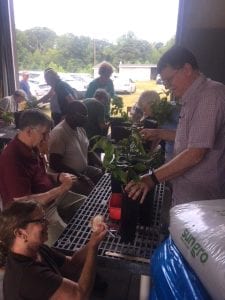
The many hands of volunteers made for a successful day.
Whether you’re working on something operational, like planting a backcross orchard, or something new and experimental, like research on small stem assays (SSAs), the key to success is having great volunteers!
Case in point: TACF has been experimenting with SSAs as an early screening technique for two years. Early results indicate that this method can help with selections in our seed orchards, but it’s a coarse selection tool; we can identify the most susceptible families, but that’s about it. We also saw a lot of “no-takes,” which means the inoculum didn’t take and the seedlings failed to develop infections. Obviously, we’d like to fine-tune our methodology so that all inoculations take, and the resulting cankers accurately depict levels of resistance among the families being tested.
Therefore, we experiment with our methods. We conducted three experiments on July 20th at the New Kent Forestry Center in New Kent, VA. All seedlings were propagated in one-gallon containers and averaged 20-30 cm in height (varied by family and date planted) and ~8.0 mm diameter at the base.
- Experiment 1: we tested three new wounding techniques, using three different strains of the blight fungus (weak strain, intermediate strain, and virulent strain) on pure Americans, pure Chinese and F1 hybrids, for an approximate total of 540 seedlings tested.
- Experiment 2: we tested approximately 450 B3F2 seedlings using a new wounding technique and two strains of the blight fungus (a weak strain and an intermediate strain). In the fall we will test planting strategies – clip the canker or don’t clip the canker.
- Experiment 3: a progeny test in which we are replicating families also being screened at TACF’s Meadowview Research Farms and Penn State. We inoculated about 360 B3F3 seedlings with the virulent strain of inoculum.
There was so much to keep straight – different inoculums, different wounding techniques – it got complicated fast. How did we keep everything organized and still manage to get it done in record time? With the help of our meticulous and super-dedicated volunteers, of course! It was a gorgeous day and we stayed cool enough in the shade of the ops building. With 24 folks working, we were able to inoculate all 1,400 chestnut seedlings in under five hours. That’s a testament to how much progress can be made with the help of good volunteers!
From these three experiments, we hope to learn important and exciting things about SSA methodology, and about the seedlings resistance and their ability to survive when replanted. So with total sincerity, I thank all my volunteers from the bottom of my heart – we couldn’t do any of this without you!
